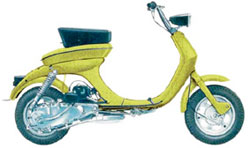Lambretta Model LUI 50 C/CL (Luna/Vega)


50C Lui SpecificationsYears: 1968 - 1969 (Lui 50 C)Amount produced: 27,812 (combined) Engine: 1 cylinder, air cooled 2-stroke Induction: piston ported Bore: 38 mm Stroke: 44 mm Cubic capacity: 49.8 cc Compression ratio: 7.7:1 BHP at rpm: 1.48 @ 4600 Transmission: 3 speed constant mesh Lubrication: 2% Carburetor: Dellorto SHA 14/12 Ignition: contact breaker & points Ignition timing: 23 degrees BTDC Breaker gap: 0.35-0.45 mm Voltage: 6 volt Wheel size: 10" Tire size: 3 x 10 Max speed: 25 mph Total dry weight: 151 lbs |
50CL Lui SpecificationsYears: 1968 - 1969 (Lui 50 CL)Amount produced: 27,812 (combined) Engine: 1 cylinder, air cooled 2-stroke Induction: piston ported Bore: 38 mm Stroke: 44 mm Cubic capacity: 49.8 cc Compression ratio: 7.7:1 BHP at rpm: 1.48 @ 4600 Transmission: 3 speed constant mesh Lubrication: 2% Carburetor: Dellorto SHA 14/12 Ignition: contact breaker & points Ignition timing: 23 degrees BTDC Breaker gap: 0.35-0.45 mm Voltage: 6 volt Wheel size: 10" Tire size: 3 x 10 Max speed: 25 mph Total dry weight: 151 lbs |
LAMBRETTA MODEL LUI 50 C/CL (LUNA/VEGA) HISTORY
The continuous search for new commercial frontiers caused Innocenti to push for a new little scooter/moped that had a 50cc engine. This super economical scooter would be sold alongside the Junior 50, but at a significantly simplified with just the essentials remaining. The exposed motor, that would not protect the rider from all the grease and grime, was similar to its well-known predecessors, the Lambretta C and D.
The qualifications of the prototype did not convince the sales department at Innocenti; it preferred to entrust this important project to the famous automobile designer, Nuccio Bertone. In a little more than three years, Bertone conceived a truly avant-garde scooter with young-looking lines but at the same time, elegant and enriched with styling cues that made this scooter one of a kind on the Italian scootering market.
The promising new model was dubbed with the pleasant name "Lui" for the domestic market, but was called "LUNA" for the export market. In the spring of 1968, the scooter was officially presented and received the highest possible critical acclaim and a lot of public kudos.
With the ad slogan, "All for Lui, and Lui for all," Innocenti began a huge advertising campaign that included not only magazine ads, but also printing school notebooks and ads in kids magazines in an attempt to kick start the sluggish scootering market. In response to the various markets, the Lui was offered in two distinct versions. The CL was the luxury version and was available in orange, turquoise, or "apple green." The more economical C did not have as many finishing touches as the CL and was available in white or "ocean blue."
The frame of the scooter was mixed with the front area using large sections of tubing, while the rear used stamped metal. The suspension was the same as the Junior since it had been tested for a few years now, except for the rear shock which was incorporated into the spring, probably just for looks.
The wheel rims and hubs were designed to give the scooter a sporty look and to make the Lui seem look even faster. For the first time on an Innocenti scooter, the hubs were made of a single piece of cast iron alloy, which was almost certainly designed to make the scooter heavier and handle better on the road. The mechanical system of the Lui had all the general characteristics of the J 50 but with a different configuration for the crankcase that was better adapted to the scooter. Another difference was motivated by trying to make the scooter look sleeker; the plastic air scoop cover used the same artistic lines as the handlebars and the rear rack.
The economic C model was different from the CL in that the front and rear lights had a more traditional shape, and the handlebars were made of a chrome tube rather than aluminum alloy. The modest price difference between the two versions made the CL the vest seller of the two. Even so, the ambitious sales predictions of the Innocenti directors was never fulfilled. After only fifteen months of production, the Lui ceased being constructed after 27,000 units had been built. At this point, the only small engine Innocenti scooter still built that did not require a license in Italy was the Junior 50, which would be made until the entire plant ceased production.
There were essentially two main reasons why the Lui was not a success: one, the futuristic lines of the scooter were never really comprehended by the general public; two, the motorcycle market had taken a steep downturn that took its toll even on the largest Italian motorcycle manufacturers such as Guzzi, Gilera, Bianchi, etc.
It is interesting to remember that the Lui was offered in a third version only for foreign markets. This model was called the "S" and was different from the CL in that it had a longer, dual-passenger seat, a raised muffler, and a rear license plate holder. During the time that it was produced, the Lui underwent very few modifications. Undoubtedly the most important was the writing on the front legshield. On the very first models, the word "Lambretta" was mounted on the left side above the "50 CL" logo, while later the emblem was eliminated and replaced with a small, rectangular coat-of-arms with "Lui" written on it and attached to the center of the legshield.
On a few cases, it is possible to find above the coat-of-arms a little chrome "Lambretta" written, as on the Luna-Vega-Cometa series that were only for export.
